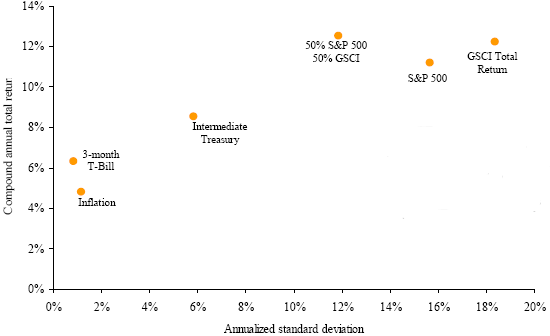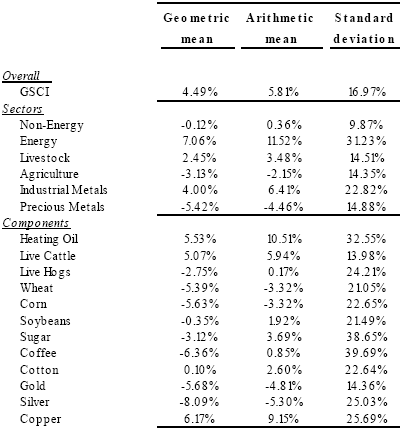We occasionally select for retrospective review an all-time “best selling” research paper from the past few years from the General Financial Markets category of the Social Science Research Network (SSRN). Here we summarize the January 2006 paper entitled “The Tactical and Strategic Value of Commodity Futures” (download count over 2,400) by Claude Erb and Campbell Harvey. Commodity futures are derivative, short-maturity claims on real assets. In this paper, the authors explore the strategic and tactical opportunities that these derivatives present to investors. Using long-run commodity futures return data as available mostly through mid-2004, they conclude that:
- Over the long term, the average annualized excess returns (above the risk-free rate) on futures for individual commodities is approximately zero, and these returns are largely uncorrelated with one another. There is little evidence of long-term return persistence among individual commodity
futures. - However, an equally weighted and monthly rebalanced portfolio of different commodity futures has a statistically significant and reliable compound average annual excess return of about 4.5%. This rebalancing return derives from portfolio diversification, not from fundamental influences such as inflation, economic growth or risk premiums.
- Over the period December 1982 through May 2004, the average excess return for commodities with a positive roll return (in backwardation) is 4.2%, compared to -4.6% for commodities with a negative roll return (in contango). But, the volatility of commodity futures returns comes mostly from variation in spot return, and this volatility swamps the roll return over this period.
- Since the inception of Goldman Sachs Commodity Index (GSCI, now S&P GSCI) futures trading, GSCI has been in backwardation as often as it has been in contango. The annualized excess return from buying GSCI futures when the term structure is in backwardation (contango) is 11.2% (-5.0%). A strategy of going long (short) GSCI futures when in backwardation (contango) generates an annualized excess return of 8.2%, compared to 2.6% for a continuous long-only approach.
- Individual commodity futures have varying exposures to unexpected inflation, with hedging efficacy correlated to roll return. Futures portfolios that best hedge inflation focus on commodities that are difficult to store.
- Evidence indicates that traditional risk factors do not explain commodity futures returns.
- Momentum appears to work for commodity futures. An equally weighted portfolio that is long (short) the four commodity futures with the highest (lowest) past 12-month returns generates annualized excess returns of 10.8%.
- A diversified portfolio of commodity futures appears to be an excellent diversifier for a traditional stock/bond portfolio.
The following chart, taken from the paper, relates compound annual total return to annualized standard deviation (risk) for various asset classes over the period December 1969 through May 2004, with GSCI as a proxy for commodities and the S&P 500 index as a proxy for stocks. Both indexes are value-weighted (via different schemes). It shows that the return on commodities is comparable to the return on stocks and that combining stocks and commodities (50% S&P 500, 50% GSCI) enhances performance.

The following table, excerpted from the paper, presents the historical excess returns of futures for the overall GSCI, six GSCI sectors, and twelve individual commodities within GSCI from December 1982 through May 2004. The performance of GSCI stems from its relatively heavy weighting on the energy sector (based on the value of energy production). The average monthly return correlation of the 12 individual commodity futures with GSCI over this period is 0.20. The average correlation of individual commodities with one another is only 0.09. The average correlation of the commodity sectors with the GSCI is 0.33, driven by the 0.91 correlation between GSCI and the energy sector.

In summary, over the long run, a diversified and periodically rebalanced portfolio of commodity futures may offer: (1) reasonably reliable equity-like returns, and (2) valuable diversification of stocks and bonds. Return momentum and roll return support tactical allocation among individual commodity futures.